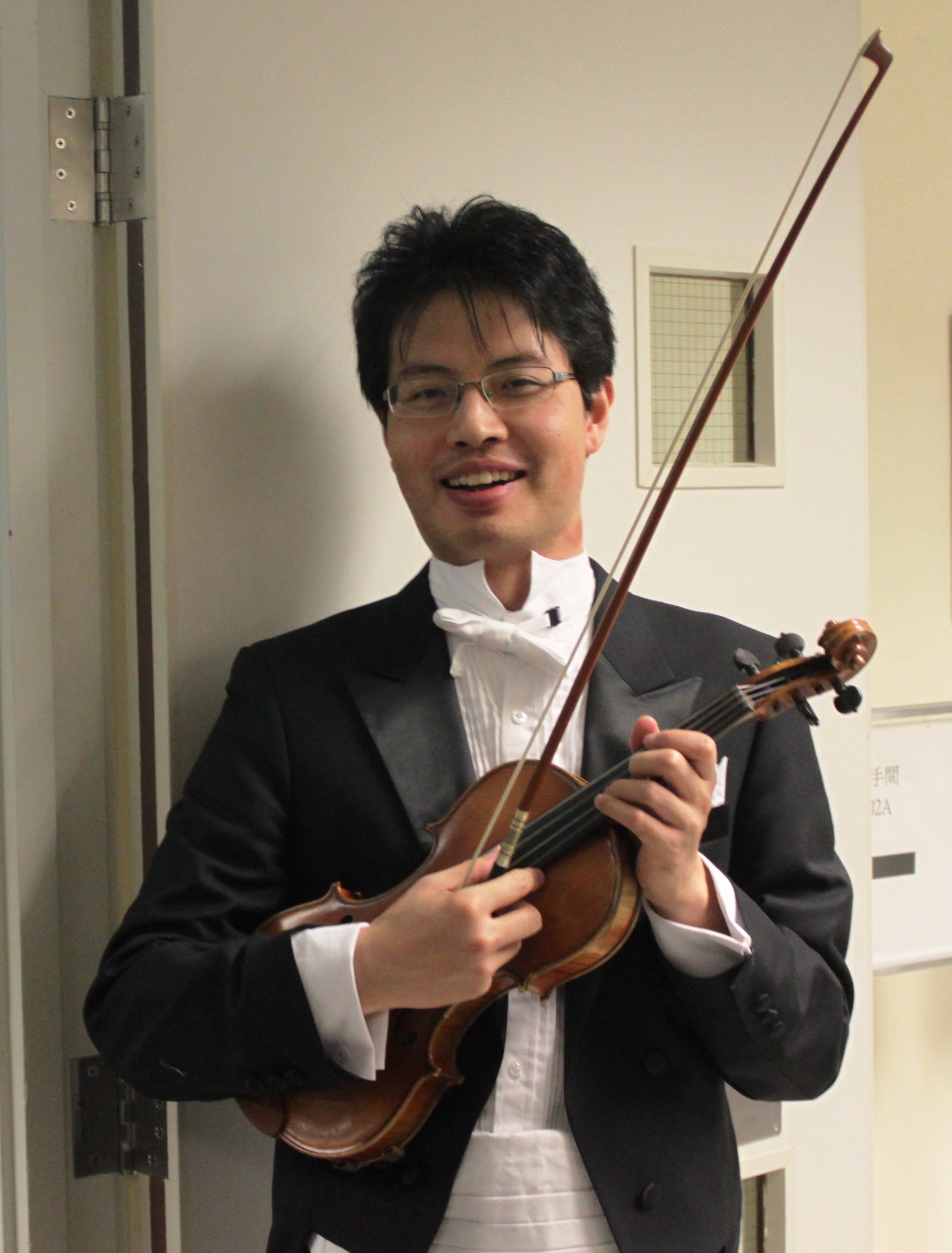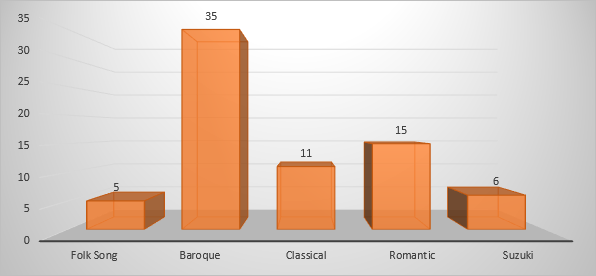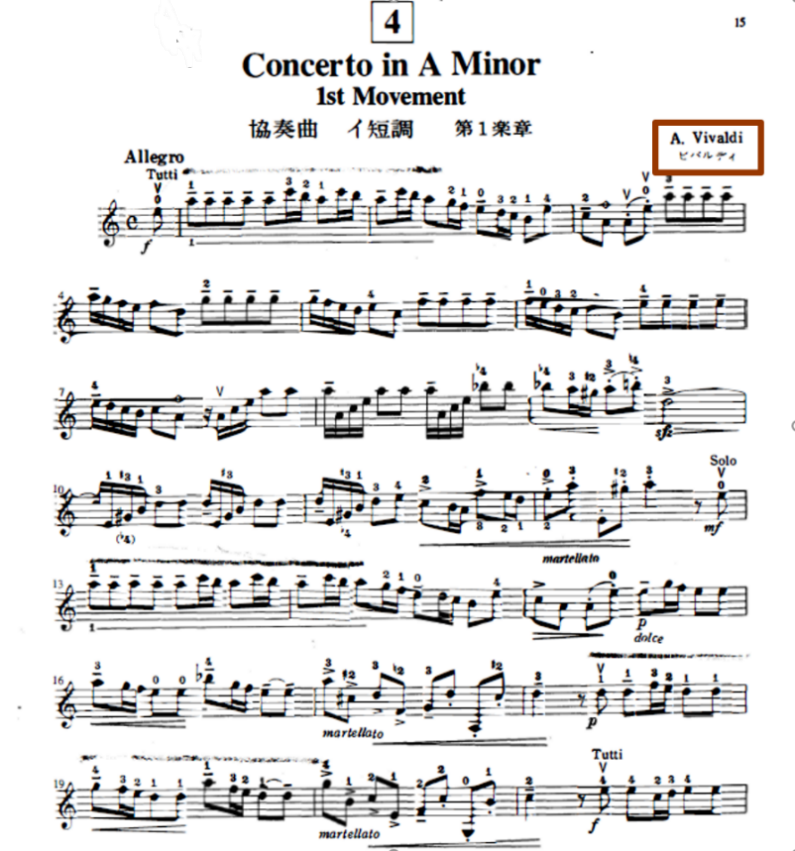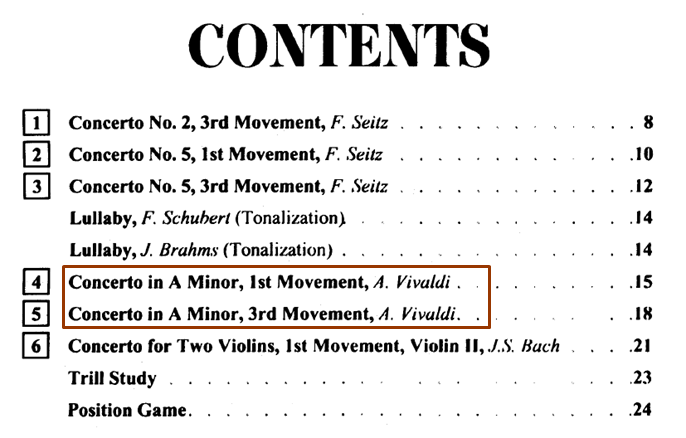Historically-informed Performance Encounters Music Education and Examination: the Case of Vivaldi’s RV 356
Read as PDF
Table of Contents
DOI: 10.32063/0508
Jian Yang
Jian Yang is Professor of Music Technology and Musical Performance Studies at the Department of Music Engineering, Shanghai Conservatory of Music, where he teaches various courses including mathematics, programming and performance. He is Deputy Director of the Sound Art Professional Committee, China Association of Recording Engineers and a Council Member of the Society for Western Music in China.
Jian obtained his Bachelor’s degree with honours in Engineering from Southeast University, his Master’s degree in Violin Performance from Nanjing University of the Arts and his Doctorate in Western Music History from Shanghai Conservatory of Music.
In 2013–14, he was granted an Overseas Visiting Scholarship enabling him to study as a visiting scholar at the Faculty of Music and St John’s College of the University of Cambridge. In 2015, he was awarded First Prize in the 14th Fok Ying Tung Education Foundation Outstanding Young Teachers of Higher Education, one of the most highly recognized prizes for young scholars in China.
Jian has published more than forty papers, a dozen books (including single and co-authored works and translations) music scores and CDs. He has also directed several national and ministerial research projects.
by Jian Yang
Music & Practice, Volume 5
Editions & Transcriptions
Introduction
In a sense, this century [the C20th] has had three avant-gardes. The first, of course, was the great new works written in it. The second was a huge store of medieval and Baroque music recovered from near-extinction and brought to a delighted public. The third avant-garde grew out of the necessary serious thought about how such unknown music should be performed.[1]
Sir Roger Norrington
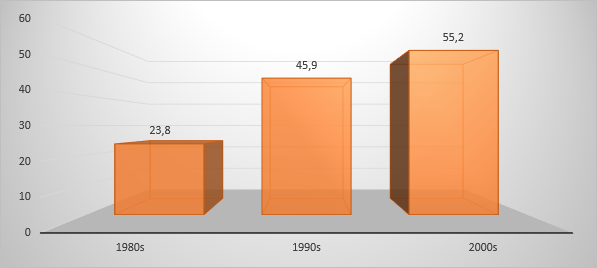
Figure 1 The Average HIP scores of 40 recordings of Bach’s Solos for Violin released in the 1980s, 1990s and 2000s (data further processed from Fabian, 2015)
In recent decades, Historically Informed Performance (HIP) has had a strong impact upon mainstream musical performance (MSP), just as Sir Roger Norrington has noted that the second and third avant-gardes have largely changed our everyday musical life and taste. According to an empirical study of recordings of Bach’s solo works for violin, carried out by Dorottya Fabian in 2015, the numbers of features such as phrasing, accenting, bowing and ornamentation showing the influence of HIP thinking and practice have generally increased in the recordings by newer generations of violinists. The original tables and charts of scores based on the HIP features were listed in her book by date of birth.[2] In Figure 1, I have further processed the raw data and made a chart of the average HIP scores sorted by the publication year of the CDs.
In an era when musical performance tends towards the literal rendering of the score and performances therefore increasingly resemble one another, HIP, as an arguably more flexible and inclusive concept than the problematic ‘authentic performance’, may actually provide a source of creativity and individuality. There are not only HIP ‘specialists’ with particular interests in early music, such as Elizabeth Wallfisch, but also a growing number of MSP musicians who are more or less inspired by HIP practices, such as Janine Jansen. As shown in Figure 2, the boundary between the two camps has merged such that, in the future, it might become increasingly difficult to find a ‘pure’ mainstream (or, as one might put it, historically ‘uninformed’) performer.
At the same time, there is plenty of music in the performance tutorial literature and in examination syllabuses that comes from the era which we perhaps associate most closely with HIP – that is to say, the Baroque era. For instance, almost 50% percent of the pieces listed in the widely used Suzuki method were selected from this period (Figure 3). Technically speaking, playing Baroque music on the violin normally only requires low positions, limited use of vibrato, simple bowing, terraced dynamics and a steady tempo, which lends it to performance by young pupils with smaller limbs and hands. However, any awareness of the HIP implications of this repertoire is usually neglected, both in terms of the editions used and the performing practices encouraged.[3]
Vivaldi’s RV 356 as a Case Study
Among Baroque composers, Antonio Vivaldi (1678-1741) features especially strongly at this intersection of HIP repertoire with early learning methods. His works have not only become increasingly popular both on the concert platform and in recordings during the second half of the 20th century but have also been used frequently for a variety of educational purposes. A typical example is his Violin Concerto in A Minor, RV 356, which frequently appears in all sorts of tutorials and syllabuses, as well as in recordings and concerts. It is the sixth work from Vivaldi’s Op. 3, L’Estro armonico (The Harmonic Inspiration), which is a set of 12 concertos for stringed instruments, first published in Amsterdam in 1711. Vivaldi scholars have described the set as “perhaps the most influential collection of instrumental music to appear during the whole of the eighteenth century”.[4] Sales were even more successful than those of Vivaldi’s famous 1725 collection, Il cimento dell’armonia e dell’inventione (The Contest Between Harmony and Invention), which contains Le quattro stagioni (The Four Seasons), the most popular set of violin concertos ever recorded.
The Nachéz edition of RV 356
The revival of RV 356 in the 20th century owed a great deal to a Hungarian violinist and composer Tivadar Nachéz (1859-1930) who produced new editions of Vivaldi’s concertos. His edition of RV 356 was published in 1912 and was dedicated to the famous French violin virtuoso Jacques Thibaud (1880-1953). On the one hand, Nachéz’s editions promoted these forgotten pieces but, on the other, they were more like romantic arrangements than serious editions exhibiting the kinds of attitudes towards scholarly respect for the original that we would now expect. They display numerous problems reflecting a generally more cavalier approach to historical faithfulness at that time, such as producing a fully-realised basso continuo part for organ, complete with thick chords instead of Vivaldi’s leaner contrapuntal textures. In the solo violin part, Nachéz inserted a considerable number of additional articulation, dynamic and expression marks, such as tenuto, crescendo and largamente (Figure 4), which clearly reflect the musical taste – but also the expectations of editorial guidance – of the early 20th century.
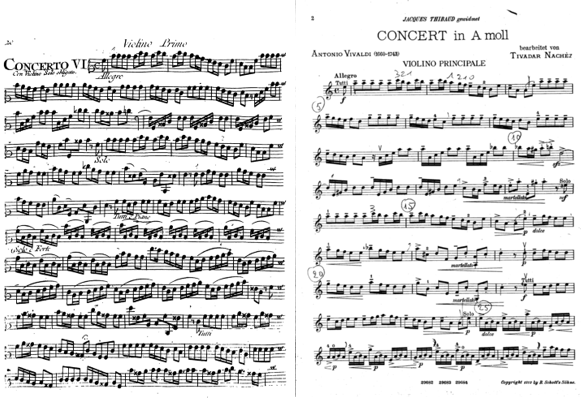
Figure 4 The first pages of RV 356, first edition 1711 and Nachéz’s Edition 1912[5]

Figure 7 Bars 44-45 of the 1st movement, first edition and bars 55-57 in proper modern notation respectively
RV 356 in Suzuki Method
It is not surprising that the Japanese educator Shinichi Suzuki (1898-1998) adopted the Nachéz editions of Vivaldi’s concertos (including those of RV 317 and 356) when developing his method books in the mid-twentieth century. He included the 1st and 3rd movements of RV 356 in Book 4 and the 2nd movement in Book 5, which was appropriate according to their respective technical demands. However, the potential problem was that he did not mention Nachéz’s heavy editorial role in the notated appearance of these pieces (see Figure 8, where the attribution is simply to Vivaldi).
As the Suzuki method subsequently became world famous, many music books and tutorials re-copied and distributed these concertos without specifying whether the music represented Nachéz’s edition or Vivaldi’s original. Therefore, whether in Europe or America, Australia or Asia, millions of violin learners around the globe have unwittingly played the Nachéz editions of Vivaldi’s concertos assuming them to be as the composer would have conceived them. As a result, they have unconsciously studied and internalised a series of Baroque pieces in a guise that, from the perspective of 18th-century music, is decidedly ‘historically uninformed’, while telling us a great deal about how late 19th-century musicians saw earlier music through the lens of their own tastes. The much visited YouTube video ‘The amazing 6-Year-Old Child Violinist Brianna Kahane Performs “Vivaldi Concerto in A Minor”’, offers a good example of this.[6] Above all, in the case of RV 356 and other works by Vivaldi, for vast numbers of violin teachers and students it is the version found in the Suzuki method that gives them their first impression of what a Baroque violin concerto should sound like.
Urtext editions and commercial recordings
This problem had hardly been noticed until the turn of the century when several urtext editions[7] were published and both the 1711 first edition and the Nachéz edition were shared online by IMSLP. On the 300th anniversary of Vivaldi’s Op.3, I also published a critical and educational edition of RV 356 in China (Figure 9) with a demonstration and a three-tempo accompaniment CD, in which I tried to balance the edition’s pedagogical purpose with reflecting something of the performing conventions that would have applied in Vivaldi’s era. For example, an extra-long editorial commentary, combining musicological investigations and educational suggestions, was included and all the added bowing, fingering and expression marks were distinguished from Vivaldi’s original notation by dotted lines and different fonts. These efforts were intended to help in clarifying issues of pedagogical expedience and scholarly scrupulousness among violin teachers and learners.
For the general public, comparing commercial recordings might be a more effective way of getting them involved in questions of style and sound relating to musical works of earlier centuries such as RV 356. In 1936, an Italian violinist Armida Senatra (1888-1973)made a set of 78rpm discs with organ and orchestra, which was one of the first available recordings of this piece, in which he faithfully followed the Nachéz edition. Then, in 1976, the Polish-Mexican violinist Henryk Szeryng (1918-1988) made a recording with the English Chamber Orchestra in what would then have been regarded as a more appropriately Baroque style. However, perhaps the most influential recording of RV 356 was that which appeared in the popular album by Itzhak Perlman (1945-) “Concertos from My Childhood”, issued in 1999. In this compilation, Perlman performs with the Juilliard Orchestra several violin concertos that have been widely used for educational purposes. For RV356, he generally follows Vivaldi’s original edition but with a mixed approach closer in many respects to MSP. By contrast, one of the notable HIP recordings was made by the Australian Baroque violinist Elizabeth Wallfisch (1952-) with the Tafelmusik Baroque Orchestra in 2007 (see Table 1).
| Year | Soloist | Orchestra | YouTube Link |
| 1936 | Armida Senatra | Unnamed orchestra | https://youtu.be/fLdtqOHT7YA |
| 1976 | Henryk Szeryng | English Chamber Orchestra | https://youtu.be/hB5SSbn0xLo |
| 1999 | Itzhak Perlman | Juilliard Orchestra | https://youtu.be/eTPiZup0QmM |
| 2007 | Elizabeth Wallfisch | Tafelmusik Baroque Orchestra | https://youtu.be/QPba-i26YNA |
Table 1 Representative Commercial Recordings of RV 356
Although Perlman’s largely MSP and Wallfisch’s HIP recordings sound very different, both of them have obtained millions of views on YouTube and are respectively ranked no.1 and no.2 by view count. If we compare these two ‘modern’ recordings with Senatra’s historical one, there are many interesting observations to be made relating to the extent of HIP awareness (Video 2). The most obvious element is tempo. Senatra adopted the Nachéz edition with its heavy orchestration and therefore played the work in a slow and sentimental manner, absorbing it into what one might regard as a typically romantic style. In contrast, Wallfisch’s HIP version with a small Baroque-style ensemble is almost two times faster and sounds pleasingly light and fluid. Perlman’s 1999 recording is just about in the middle between Senatra’s and Wallfisch’s. Besides tempo, there are many aspects reflecting the presence or absence of HIP features, such as the use or not of Vivaldi’s original notation, Baroque pitch, period instruments, articulation, vibrato, improvised ornamentation and the realization of basso continuo. Taken together, these result in not only the overall artistic effect but also specific technical demands being totally different from one recording to the next.
Video 1 Bars 1-46 of the 1st movement, tempo-dynamic curves generated with www.vmus.net developed by the author
HIP Encounters the World of Music Education and Examination
Replacing the Nachéz edition with Vivaldi’s original?
The publication of urtext editions and the issuing of commercial recordings with increasing HIP awareness has aroused continuing controversy among violin teachers. Some of them have insisted on replacing the Nachéz edition in the Suzuki method with a new one more faithful to Vivaldi’s original, while others have preferred to retain Nachéz edition for its enduring ‘pedagogical value’. Interestingly, the favouring of replacement seems to have been geographically unbalanced. The European Suzuki Association seems to have been the most pro-replacement, which is proportional to the generally strong HIP trend in this area, while other parts of the world, such as America and Asia, seem to have been relatively indifferent to the potential problems of using non-HIP editions.[8]
In the end, the compromise result was that in the newest Suzuki international edition, published in 2008, Nachéz’s name was added next to Vivaldi’s and it was agreed that, in future competitions or exams, specific editions should be assigned for the avoidance of ambiguity. However, such an important revision has not been fully adopted in other Suzuki editions; nor has it in numerous related tutorials. For example, in the newest Chinese edition of Suzuki method books, published in 2009, Vivaldi is still listed without qualification as to the edition used despite the score being that of the Nachéz editions (Figure 10). This might be associated with the geographically unbalanced attitudes towards the HIP already commented upon.
International 1995
International 2008
Chinese 2009
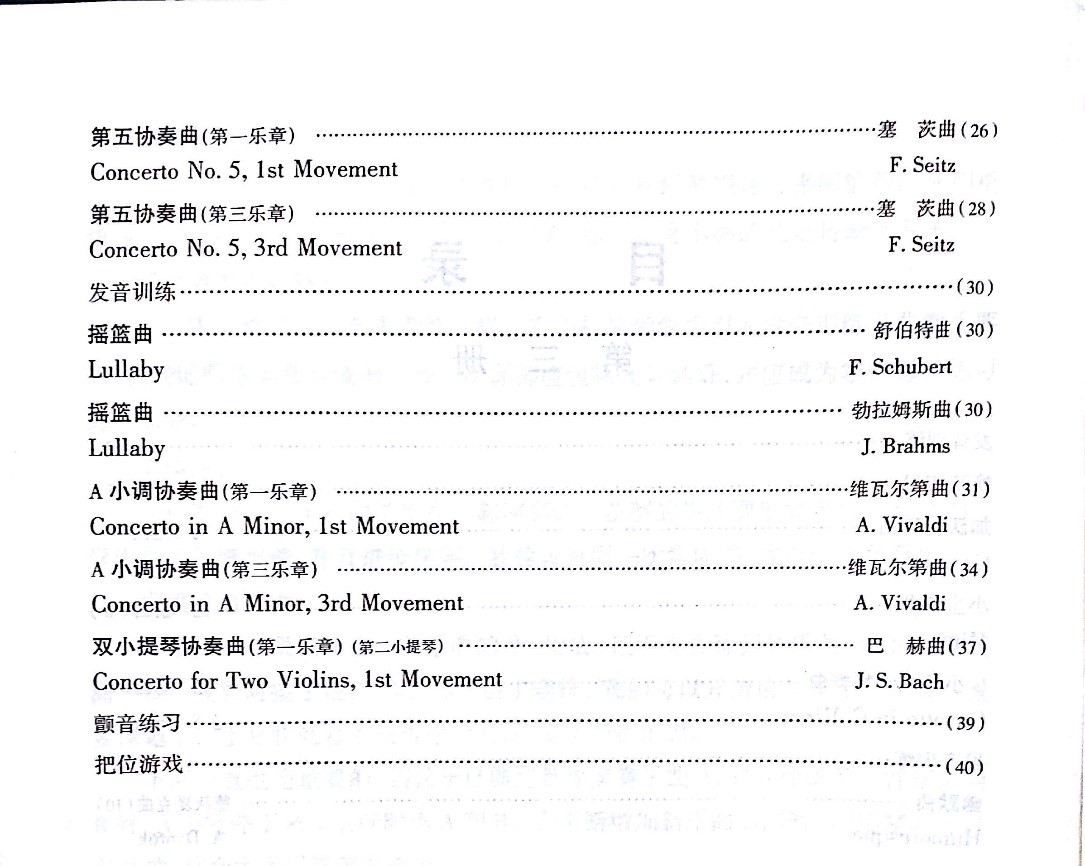
Figure 10 The content pages of Suzuki book 4, international editions 1995, 2008, and Chinese edition 2009
The diversified grading of RV 356 with different editions
As discussed before, HIP awareness determines not only the overall artistic effect, but also the specific level of technical difficulty in Baroque concerti. Therefore, the grading of Vivaldi’s RV 356 in examinations is significantly different depending on the edition used and the level of HIP awareness expected. In the 2012-15 syllabus of the UK’s Associated Board of the Royal Schools of Music (ABRSM), the first movement of RV 356 is placed in Grade 7 out of 8 (8 being the highest) with Vivaldi’s original bowing and other HIP related requirements such as tempo and articulation being indicated in the score published by the Board. However, in the syllabuses of the Shanghai Conservatory of Music (SCM) and most other Chinese exam bodies, the same movement is usually in graded 4 out of 10, with the editions published being based on Nachéz’s romantic and ‘pedagogically-friendly’ arrangement (Figure 11). Perhaps, the recent updating of Central Conservatory of Music’s exam syllabus is more or less a symptom of the rising HIP trend: in their old syllabus, before 2010, the first movement of RV 356 was in grade 3 out of 9 while, in their newest tutorial book, the same piece has been upgraded to grade 5 out of 9 (Figure 12).
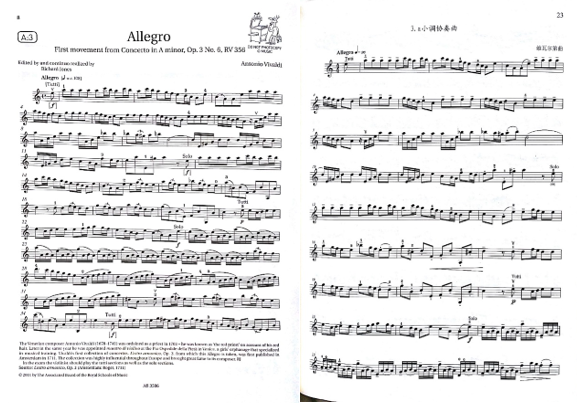
Figure 11 The first pages of RV 356, the ABRSM violin pieces books 2012-15 grade 7 and Shanghai Conservatory of Music violin pieces books 2011 grade 4
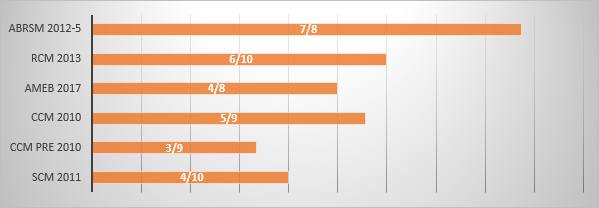
Figure 12 The diversified grading of RV 356 by various examination bodies with different editions: ABRSM (The Associated Board of the Royal Schools of Music, UK) 2012-15 syllabus with quasi urtext edition: 7/8, RCM (The Royal Conservatory of Music, Canada) 2013 syllabus with Suzuki edition: 6/10, AMEB (Australian Music Examinations Board) 2017 syllabus with unknown edition: 4/8, CCM (Central Conservatory of Music, China) 2010 newest syllabus with a mixed edition: 5/9, CCM pre 2010 syllabus with a mixed edition: 3/9, SCM (Shanghai Conservatory of Music, China) 2011 and most other Chinese exam bodies syllabuses with Nachéz edition: 4/10.
Reflections on Musical Performance Pedagogy
Is education falling behind?
From the evidence presented above, it is obvious that HIP-related considerations in educational practice and publishing are generally insufficiently regarded and that such improvements in this state of affairs as have taken place recently are modest and geographically unbalanced. The series editor of ABRSM’s Performer’s Guide, Anthony Burton, lamented in the 2017 edition of the book series that: “it has become increasingly clear that all performances of music of the past can benefit from the knowledge and experience gained by the ‘early music movement’, [but] one area which has lagged behind in this has been education”.[9]
Technical training before stylistic awareness?
Music teachers – and therefore their students, too – tend to believe that playing skills should be adequately developed before and, to some extent, isolated from the interpretation of music itself. This view goes hand-in-hand with the belief that the pieces played by beginners are teaching materials, rather than works which need to be considered historically and artistically. In this case study, the problematic Nachéz edition was supported by some violin teachers for its ‘pedagogical value’, which suggests precisely this questionable separation of artistic and pedagogical considerations. The assumption is that once the basic skills are in place, students can then turn with a new, artistically-oriented attitude to the music, some of which will already be ‘under their fingers’. However, many scholars have confirmed that “it is common for performers on record to have their personal styles established quite early and not to change them radically thereafter.”[10] Also, technical aspects such as bowing, and fingering are closely related to interpretative intention, and those highly impressive HIP performances given by mature artists require a different way of playing from their MSP equivalents. Therefore, it seems counter-intuitive, and potentially damaging to subsequent development, to think about technical training without stylistic considerations playing some kind of role from the earliest stages.
HIP initiation in early education?
Nowadays, historical awareness is so crucial, applying as it does not just to music of the eighteenth century but that of the nineteenth and early twentieth too, that it seems perverse and inefficient to ignore it in the first place and then introduce it afterwards (even if such an approach could really work). We probably need to think about a fundamental question: do we learn music by using an instrument or learn an instrument by using music? In other words, is music the means or the end? If most people, as one would hope, agree that the music itself is the ultimate goal, and that the often long and arduous journey towards mastery of an instrument makes sense only in the context of using that mastery to realise one’s musical needs and ambitions, then this has profound implications for the whole shape and trajectory of music education. Pieces like Vivaldi’s RV 356 are not only ‘teaching material’ but also ‘works of art’, deserving of our understanding in terms of what they have to say to us artistically. If we make our first acquaintance of them only in the former context, something of that separation is likely to remain in our subsequent relationship with them.
Any art-work of any substance has the capacity to speak to different generations and cultures in terms that they find intelligible and congenial. Nachéz’s editions of Vivaldi, and performances made using them such as Senatra’s in the 1930s, are not to be disparaged just because they no longer resonate for us in the same way that they did for those musicians in their time. But, for better or worse, in our times HIP has become the prevailing orthodoxy for the performance of earlier music. As has been argued by many commentators, in many ways it is a ‘modern’ (or even ‘post-modern’) phenomenon that defines us and our age, rather than fixing for all eternity the essential nature of music such as that composed by Vivaldi.[11]
Clearly, we should not repeat the common historical error of believing in the unique correctness of our own way of doing things; but if we wish our music education to be a source of inspiration and creativity, we need to ensure that there is not a dislocation between the musical sounds that surround us in our first years of instrumental lessons and those that we will encounter at more advanced levels and in the recordings we listen to and concerts we attend. The concept of music as a performing art, vibrant and relevant to us in our modern times, should be present from the moment that we first conjure sounds out of an instrument. Therefore, the stylistic and interpretative aspects of musical performance should be better taught and should be combined as early as possible with training in the technical requirements of specific instruments.
Conclusion
This paper, with Vivaldi’s RV 356 as its focus, has not only investigated how the HIP concept has spread among even MSP performances of works from the eighteenth century, but has also exposed the gap between this development in the artistic sphere and the persistence of earlier attitudes surrounding the use of such works as ‘teaching pieces’. In addition, by focusing on education and examination, it has predicted a direction in which things might go in the future. The kinds of changes called for largely depend on tutoring manuals, examination syllabuses and teaching strategies reflecting greater historical and stylistic awareness. In the case of RV 356, the general trend towards HIP or ‘HIP-inspired’ performances is obvious, but the education field seems to have been falling behind public taste and some geographical imbalance is also noted. In practice, there are numerous pieces similar to RV 356 in the standard teaching repertoire. Ideally, the new generation of young performers should be able to absorb HIP elements naturally as part of both their creative motivation and their acquisition of technical competence.
As a coda to this paper, I should like to share the recording of a special performance at the 5th International Conference of the Performance Studies Network, where this paper was presented. In Video 3, my son Silas (aged 9) plays the 3rd movement of RV 356 with his new toy baroque bow[12] and, hopefully, demonstrates a rather more balanced approach to reconciling HIP awareness and pedagogical purpose than can still commonly be found in many teaching environments.
Video 2 Silas plays the 3rd movement of RV 356 at Norwegian Academy of Music, Oslo, on July 8, 2018 using the accompaniment provided on the CD shown in Figure 9
Acknowledgements
This paper is sponsored by Art Disciplinary Projects “Musical Performance Studies in an Interdisciplinary Perspective” (No. 16BD052) supported by National Social Science Fund of China, Funding for the Projects of China’s “Double First Class” University Construction and Funding for the Projects and Strategic Innovation Team Supporting Shanghai High-level Local University Construction. The author gratefully acknowledges the constructive edits and comments of Dr Jeremy Cox on this paper and those of Prof. John Rink on its abstract.
Bibliography
Brown, Clive and Roger Norrington, Classical and Romantic performing practice 1750-1900 (Oxford: Oxford University Press, 1999)
Burton, Anthony, ed., A performer’s guide to music of the Baroque period (London: ABRSM Publishing, 2002/2017)
Butt, John, Playing with history: the historical approach to musical performance (Cambridge: Cambridge University Press, 2002)
Cook, Nicholas, Eric Clarke, Daniel Leech-Wilkinson and John Rink, eds, The Cambridge companion to recorded music (Cambridge: Cambridge University Press, 2009)
Fabian, Dorottya, A musicology of performance: Theory and method based on Bach’s solos for violin (Cambridge: Open Book Publishers, 2015)
Fabian, Dorottya, “Analyzing Difference in Recordings of Bach’s Violin Solos with a Lead from Gilles Deleuze”, Music Theory Online, 23.4 (2017), <http://mtosmt.org/issues/mto.17.23.4/mto.17.23.4.fabian.html> [accessed 25 August 2019]
Haynes, Bruce, The end of early music: a period performer’s history of music for the twenty-first century (Oxford: Oxford University Press, 2007)
Lawson, Colin and Robin Stowell, The historical performance of music: an introduction (Cambridge: Cambridge University Press, 1999)
Kivy, Peter, Authenticities: Philosophical reflections on musical performance (Ithaca: Cornell University Press, 2018)
Rink, John, Helena Gaunt and Aaron Williamon, eds, Musicians in the Making: Pathways to Creative Performance (Oxford: Oxford University Press, 2017)
Taruskin, Richard, Text and act: Essays on music and performance (Oxford: Oxford University Press, 1995)
Endnotes
[1] Clive Brown & Roger Norrington, Classical and Romantic performing practice 1750-1900 (Oxford: Oxford University Press, 1999), p. vii.
[2] Dorottya Fabian, A musicology of performance: Theory and method based on Bach’s solos for violin (Cambridge: Open Book Publishers, 2015). See Figure 3.1 and Table 3.3 in Chapter 3: https://www.openbookpublishers.com/htmlreader/978-1-78374-152-6/ch3.xhtml#_idTextAnchor066 [accessed 25 August 2019].
[3] See “Suzuki Violin Pieces in their Original Forms”: http://www.markpolesky.com/suzuki/.
[4] https://en.wikipedia.org/wiki/L%27estro_armonico [accessed 25 August 2019].
[5] Both available at: https://imslp.org/wiki/Violin_Concerto_in_A_minor,_RV_356_(Vivaldi,_Antonio) [accessed 25 August 2019].
[6] See https://youtu.be/OF_LGudzTMI
[7] Such as: Vivaldi, Antonio, Eleanor Selfridge-Field & Edmund Correia, eds, L’Estro armonico Op. 3, in Full Score – Concertos for Violins and String Orchestra (New York: Dover Publications, 1999).
[8] See the discussions at: https://suzukiassociation.org/discuss/5535/ [accessed 25 August 2019].
[9] Anthony Burton, ed., A performer’s guide to music of the Baroque period (London: ABRSM Publishing, 2002/2017), p. ix.
[10] Nicholas Cook, Eric Clarke, Daniel Leech-Wilkinson & John Rink, eds, The Cambridge companion to recorded music (Cambridge: Cambridge University Press, 2009), p. 257.
[11] See, for example, Richard Taruskin, Text and act: Essays on music and performance (Oxford: Oxford University Press, 1995), especially ‘The Pastness of the Present and the Presence of the Past’, pp. 90-154.
[12] It is actually a modern bow, but in the shape of a baroque bow, which is easy to play with.

